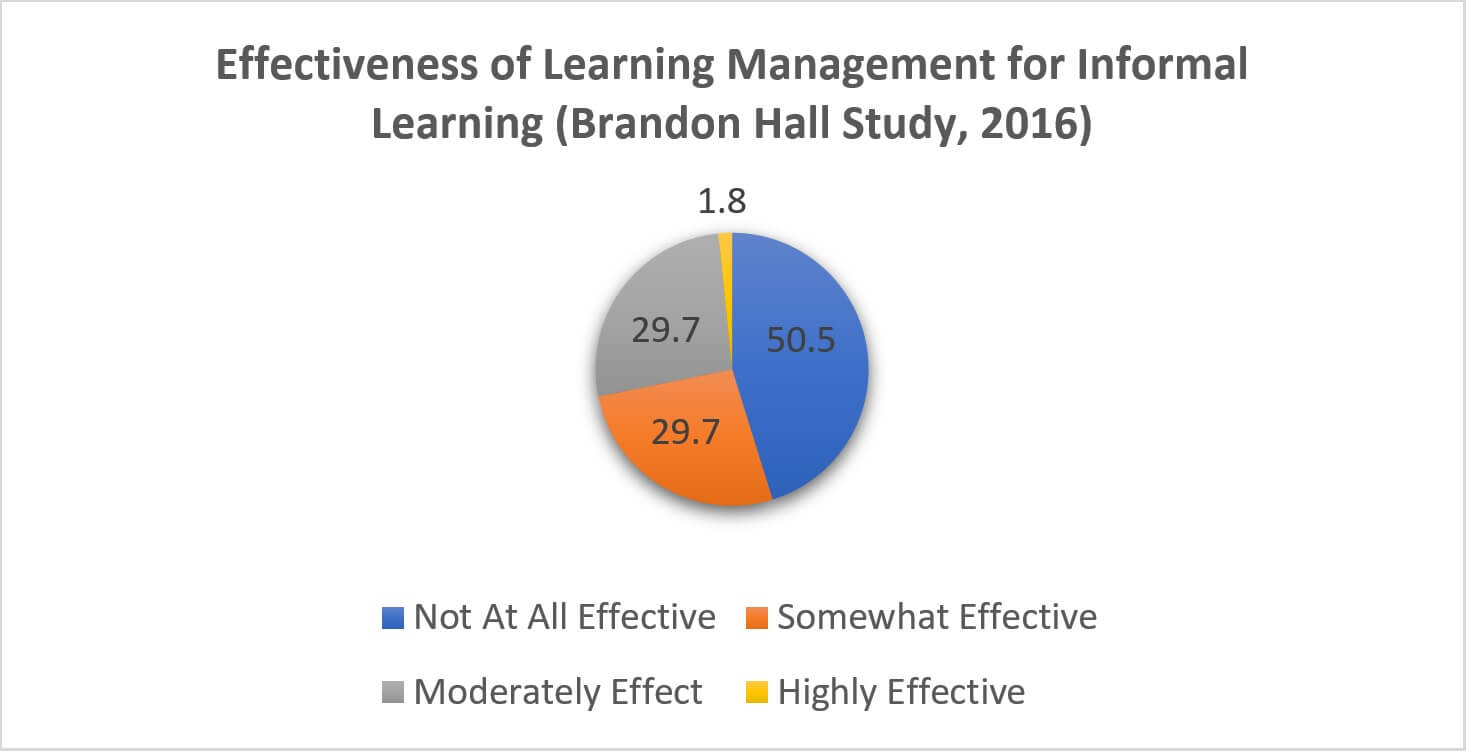How to Track Informal Learning in Your LMS
Shauna Carson
Employees acquire the skills, knowledge and competencies they use at work in all kinds of ways, even using Google and YouTube to solve their problems before asking a colleague. Now what if I told you that 94% of employees engage in some form of informal learning everyday, or that "the highest level of learning with the deepest cognitive impact is informal learning", but that none of this is tracked by organizations? This is a huge lost opportunity!
The goal of this article is to familiarize readers with informal learning, provide a few reasons why you should start measuring informal learning today, and identify ways you can use your learning management system to engage learners and track informal learning activities.
For those people who think informal learning shouldn't be tracked because it's 'informal' or that by tracking informal learning it becomes formal and therefore defeats the purpose, please read on as I hope to convince you that this isn't true.
But first, what is informal learning?
Jay Cross defines formal and informal learning through an analogy, one which I constantly share with my students:
Informal learning is like riding a bicycle: the rider chooses the destination and the route. The cyclist can take a detour at a moment's notice to admire the scenery.
Formal learning is like riding a bus: the driver decides where the bus is going; the passengers are along for the ride. People new to the territory often ride the bus before hopping on the bike.
Both types of learning ultimately help you reach your goal. The problem in traditional workplaces today is everything has to be monitored and tracked.
Therefore, HR and training departments put almost all their energy into driving busses (a.k.a. formal training programs). This is concerning because how we predominantly acquire knowledge in the workplace is fundamentally changing.
With the exponential growth of digital connectivity, we have moved from a world where information was scarce, to one of information abundance. Training departments, therefore, need to adapt and find ways to incorporate informal channels into their formal learning strategies.
Why should you start measuring informal learning?
It's common in the workplace for learning to occur in classrooms and via eLearning, however, this only accounts for about 10% of an organization's actual learning.
According to Kelsey Cochran, "even within that 10%, retention of information delivered through those formal channels is too low - most learners forget up to 90% of the material within days".
This is why there is value in applying the 70:20:10 model:
- 70% of your learning should come from experiences - solving difficult tasks and challenges at work and through real-time group work and collaboration;
- 20% of your learning should come from other people such as your peers; and
- 10% of your learning should come from formal learning sources like seminars and eLearning courses.
If the statistics above don't convince you, here are three other reasons why you should start measuring informal learning:
- According to a Brandon Hall Group: Social & Collaborative Learning Study (2016), 24.1% of respondents felt that employees need to connect with learning resources on a daily basis, and 36.7% of respondents expected that their employees would need to connect with learning resources on a weekly basis. That means over half (approx. 61%) of all respondents thought that embedded learning was essential for superior job performance.
- By incorporating informal learning strategies into your training programs, there is a greater chance of determining knowledge gaps. Yes, a learning needs assessment can also help you achieve this, however as Victoria Hoffman writes, "with more and more baby boomers retiring and millennials entering the workforce, companies face the reality of growing knowledge gaps within their organization. Not only can social learning help to fill those knowledge gaps, but informal learning data in your LMS "What is a Learning Management System (LMS)?") can help determine where they might lie".
- Informal learning metrics can also help to influence and modify learning content. Sometimes, your employees share information that you would never have thought to incorporate into your learning program. Similarly, forums, discussion boards and Q&A threads can be consolidated into simple job-aids and reference tools.
Furthermore, organizations that are considered High Performing Organizations:
- Support proactive learners and empower employees to take responsibility for their own development.
- Provide easy-to-use (and access) resources such as user-generated content features and social collaboration tools that support all types of learning, both formal and informal.
- Reward and genuinely recognize employees for their learning achievements. Research shows that appreciation and recognition are major factors that motivate employees to work harder and aim higher, ultimately leading to increased performance.
How can you use your LMS to track informal learning?
Before answering this question, take a look at the graph below.

Source: Framework: Formalizing the Informal
It's not surprising that 50% of respondents felt that current learning management strategies for informal learning are Not At All Effective. The strategies presented below are aimed at changing this.
Strategy 1 - Allow employees to organize themselves into the groups and hierarchy that interest them
Traditional LMSs organize people and content by hierarchy, by topic and by content thread. Learning is then assigned to learners through learning paths, without their input.
However, informal learning, which often finds a place in social networks "represents a gradual decentralization of content". In social networks, these associations are created by the users themselves, not the administrator. Topics are not assigned centrally, but are instead created by individuals tagging certain content with terms or categories they choose.
There is a bunch of new research that looks at the ways in which technology can support informal learning, but if it's to be implemented, training departments, instructional designers and learning program developers need to shift their traditional learning values and embrace learner-centric or decentralized approaches and social network structures, which are popular on social media platforms.
Strategy 2 - Encourage employee-curated content
Allow employees to curate resources that they can share with others. Training resources do not necessarily need to come from corporate or HR.
It's just as useful, and effective, to empower all employees to recommend topics and resources that they find helpful. This is generally information they've found on their own as they work through their daily job-related challenges.
But empowering employees to find content is only the first step.
You then need to provide a venue for them to share this information.
Ensure that your LMS has the capability for users to share interesting articles, to post questions and answers and create a dialogue around a topic.
It's a good idea to leverage platforms that use the concept of 'spaces' to foster discussion among members. If your LMS has this capability, you can likely report on it. Consider evaluating the following metrics:
- Self-led learning - how many learners are adding their own content? Are they sharing things they learned with others via forums and discussion boards?
- Number of times a user asks and answers questions - how often are learners posting on forums? Opening communication channels helps you to capture the informal learning that takes place.
- Participation - monitor likes, dislikes, most popular feeds, and so on. Knowing how many times someone has posted something new or has simply participated is one way to measure learner engagement.
Strategy 3 - Encourage employees to enroll in courses and participate in other learning activities outside of your organization and then track these achievements
By allowing employees to earn external qualifications offered by other organizations, and then by recognizing these achievements, you empower employees to bring this knowledge back into your organization.
Your learning management system should allow learners to store and post all their learning achievements and be recognized for them, regardless of where the learning took place.
The simplest way to track this is through Open Badges.
Open Badges can be earned from over 3,000 organizations around the world. As a learner accumulates badges, they can share them across social media platforms such as Facebook, LinkedIn and Google+, and each badge contains data about the skills required to earn the badge as well as information about the issuing organization.
If your LMS has a built-in backpack, learners can upload their earned badges and then you can report on this. Consider the following metrics:
- Frequency of external qualifications (or Open Badges) earned.
- Areas of interest - what external learning opportunities are your employees interested in?
Strategy 4 - Consider your metrics
A blog post about tracking learning wouldn't be complete without a list of additional metrics you should be able to pull from your LMS as they relate to informal learning. If tracking informal learning is a priority for your organization, your LMS should be able to provide:
- Reports on peer review activity
- Reports on activity per learning path
- Ratings on content contributions (user-generated content)
- Sharing activity
- Content views
- Reports on likes and dislikes buttons
- Reports on various forum activities
Conclusion
Informal learning encompasses the daily conversations we have with our peers, the articles we read on the internet, our own observations of others' behaviour, trial and error, and so much more. Yet organizations don't fully recognize the impact these learning activities have on performance.
This article briefly introduced you to informal learning, provided a few reasons why you should start measuring informal learning, and identified four strategies you can use to ensure your learning management system engages learners and tracks informal learning activities.
Do you want to incorporate informal learning into your learning programs, or are you looking for an LMS that supports informal learning? Create your own learning portal today!
Free eBook
Maximizing Your LMS Demo and Free Trial
Learn how to maximize your time investment and choose the right LMS for your organization!
TopicsChoose Topic
📘 Ready to Elevate Your Learning Strategy?
Explore our comprehensive library of eBooks and tools on learning resource development, competency-based learning, and LMS implementation. Transform your training programs with insights from industry experts and practical templates.
Shauna Carson
Shauna graduated from the University of Toronto in 2002 with a Master of Arts in English before moving home to Calgary to work in the fast-paced, detail-oriented oil and gas industry. Now certified as a technical writer, Shauna is comfortable writing in a variety of styles, and for a variety of audiences.

